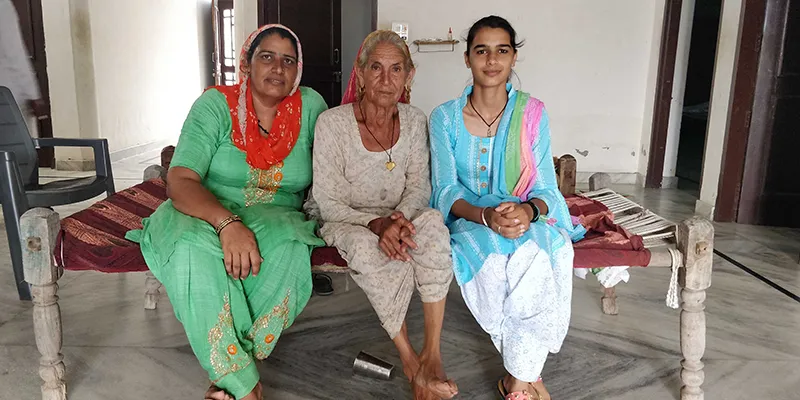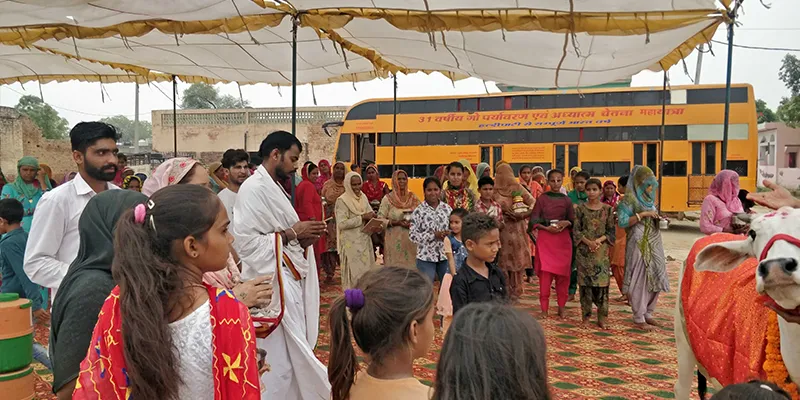Ghoonghat continues to limit women’s autonomy in Haryana
The ghoonghat continues to bar women, especially in the Hindi-speaking rural belt of the country, from making progress.
“I felt suffocated under the ghoonghat (veil). But he would fight with me and force me to draw the veil when in front of my mother-in-law or any other member of the family,” says Shushma Bhadu Bishnoi about her husband, Bhagwan Das Bishnoi.

Woman in Chaplamori village taking care of her children as the Village Sarpanch looks on. Picture credit: Poorvi Gupta
Embedded in a patriarchal tradition, the ghoonghat or the purdah system can be traced back to the Vedic period in India. A tool of oppression, the ghoonghat has kept upper-class women in seclusion and away from the eyes of men. Today, while times have changed and women have fought and dismantled this discriminatory system to a large extent , the ghoonghat continues to bar women, especially in the Hindi-speaking rural belt of the country, from making progress.
Forty-year-old Shushma got married at the age of 18 and came to her marital home in the late ’90s. Since then, for over a decade she was compelled to keep a ghoonghat — one of the many visual signifiers of marital status among certain communities of Hindu women in India. While the ghoonghat tradition may have been wiped out in most parts of the country, it is still alive and thriving in Haryana.
“If I didn’t keep the veil, my husband would snap at me. He would say that the ghoonghat is our tradition, how could I resist it? We had several tiffs around it over the years,” recounts Shushma, who belongs to a zamindar family in the village.
In 2010, Shushma became the first female Sarpanch of Dhani Miyankhan — a hamlet in Fatehabad district, Haryana. It was for the first time that a Sarpanch was to be elected from her village and the state mandate was that it had to be a woman Sarpanch. After becoming the village Sarpanch, Shushma had to meet people outside the four walls of her house and address meetings, all this while keeping the veil.
Lifting the veil

L to R: Shushma Bhadu Bishnoi with her mother-in-law and daughter. Picture credit: Poorvi Gupta
"My husband was worried about me lifting the veil, but he supported me in my decision to contest for Sarpanch election as everyone rooted for me,” she recalled adding that only after it started to create issues as she had to visit offices in Fatehabad and meet officials, did her husband allow her to lift the veil outside the house.
“I thought lifting my veil outside but drawing it at home was more problematic, so I told him either I’ll lift my veil forever or I won’t participate in any of the Panchayat activities,” Shushma resolved and won the fight over breaking the ghoonghat system first in her own house and then in her village.
In 2012, she convened a Maha Panchayat of 25 villages in her village government school compound where all the women assembled and pledged to lift the veil once and for all.
“At that time everyone lifted their veil but if women went back to draw their veils again, I can’t guarantee that. Initially, the men in the village got really upset. They even abused the women in their houses.”
Nirmala Devi, 39, also lifted her veil for the first time at the Maha Panchayat. “
When the Sarpanch of the village made us pledge to lift the veil, we all did. While things have changed since, I still have to keep the veil in front of the older men in the family and the husband of my daughters. I won’t lie. It is a long-standing tradition so it’s difficult to forego it completely,” says Nirmala.
“Honor is in the eyes of the people, not the veil. Women can go around the village without hiding their faces, but men need to have respect for the women in their own eyes,” Shushma added.
While Shushma’s efforts brought some change in Dhani Miyankhan, almost a decade later, the ghoonghat system is still alive.
Conditioned to cover the head

Scene from the procession to honour the Gau Mata in Dhani Miyankhan village, Fatehabad district, Haryana. Picture credit: Poorvi Gupta.
Just a few blocks down in the village, there was a procession happening to honor the Gau Mata (‘Holy cow’) where many women had their faces completely covered with their dupatta. One of them, Tona Devi, 43, told us, “I don’t know what life looks like without the veil. It has become a way of life and a way of respecting the older people in the village. I can’t roam around in the village without the veil.”
Older women say that the tradition will die with them and that they don’t encourage their daughters or daughters-in-law to follow suit. But reality shows a different picture. Monika Bishnoi, 25, a young woman married in the village keeps the veil in front of her father-in-law and other men in the family. She, however, says that she can wear a top and a pyjama at night when everyone’s asleep — a sign of modernity for her.
“I don’t like it, but I can’t do much about it. I must keep the veil. I feel shy in front of my father-in-law. Although I got married without a veil, after coming here, I have always kept it,” says Monika.
With the ghoonghat system being passed down from generation to generation, it sees no end soon. Apart from deterring women from living with freedom, it also perpetuates the notion that if women are veil-free then crimes like eve-teasing, street harassment are justified in villages. Today, when we speak of how victim-shaming — in cases where women are blamed for their clothes in sexual harassment crimes — has only worsened women’s lives and put the cause of women empowerment several steps back, the ghoonghat system has done no good.
How long before the ghoonghat system dies?
Despite women like Shushma and many others taking strong steps to curtail the veil, it continues unabashedly in the villages. And when state governments propagate such regressive traditions, it only further legitimizes the practice. In 2017, the Haryana government issued an advertisement in Krishi Samvad, a government-owned magazine, depicting the practice of ghoonghat with the caption — “Ghoonghat ki aan–baan, mhara Haryana ki pechchan” (Pride of the veil is the identity of my Haryana).
Preeti Bhardwaj, officiating chairperson of the Haryana Commission for Women, weighs in on it and says, “It is a paradoxical situation between the cities and the villages of Haryana. Women, who are from the interiors but have stepped out and gone to the cities, have changed and no longer keep the veil. There are also several women Sarpanch who have lifted the veil and showed an exemplary spirit to the entire village but then there are women who are happy being under the veil also and that includes educated women as well. Women tend to live by customs and traditions that have been going on for generations and they don’t mind it.”
Bhardwaj adds that women in Haryana aren’t forced to keep the veil. While it may be true for some, most women are conditioned to keep the veil and don’t know otherwise. There is also a huge risk of being ostracized and mocked at by the community in the village that scares the majority of the veiled women from lifting it.
Rajbala Kataria, joint director of the Integrated Child Development Scheme (ICDS) in the Haryana Women and Child Development Department, agrees that the ghoonghat system is here to stay in the villages of Haryana. “It has been wiped out from the cities and among the educated class, but it exists even today in villages. However, we have seen a change over time where women don’t keep the veil in the house but draw it once they are out of their homes,” says Kataria.
(Edited by Sanhati Banerjee)
This story is part of the Laadli Media Fellowship - A Population First initiative supported by UNFPA.








